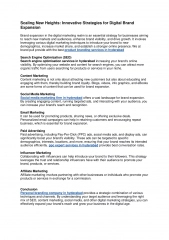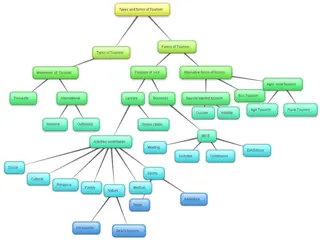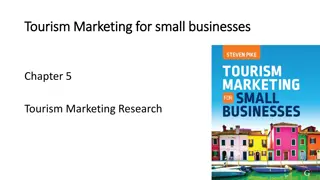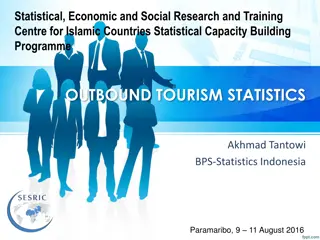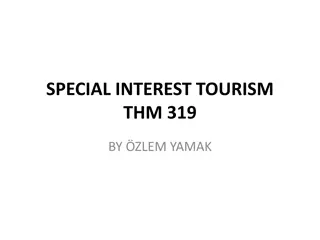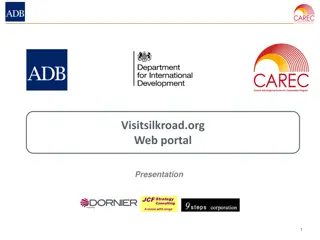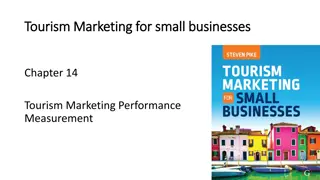Understanding Tourism Branding in Small Businesses
Enhance your knowledge of branding in tourism marketing, including brand identity, positioning, and image. Discover the importance of standing out in a competitive tourism market and learn about the co-creative process of developing a strong brand. Explore the main aims of branding and the three key components of tourism branding. Watch a video on the role of brands in the tourism industry to deepen your understanding.
Download Presentation

Please find below an Image/Link to download the presentation.
The content on the website is provided AS IS for your information and personal use only. It may not be sold, licensed, or shared on other websites without obtaining consent from the author. Download presentation by click this link. If you encounter any issues during the download, it is possible that the publisher has removed the file from their server.
E N D
Presentation Transcript
Tourism Marketing for small businesses Tourism Marketing for small businesses Chapter 7 Tourism Branding
Chapter learning aims Chapter learning aims To enhance your understanding of: the role of branding in tourism marketing branding as a co-creative process involving a brand identity, brand positioning and brand image the seven-stage brand positioning process
Key terms Key terms Brand identity The desired brand image that differentiates the organisation from competitors. How the organisation aspires to be perceived in the market. Brand image How the organisation is actually perceived by consumers, which might or might not be similar to that intended in the brand identity. Brand positioning A set of marketing activities that attempt to achieve congruence between the actual brand image and the brand identity, through a focused value proposition that is meaningful to consumers.
Branding rationale Branding rationale For any tourism purchase decision, consumers are spoilt by choice of available services offering similar features and benefits. Owning a brand that stands out from the crowd and simplifies decision making for the consumer represents a source of competitive edge.
Video link Video link The role and importance of brands https://www.youtube.com/watch?v=JKIAOZZritk
Main aims of branding Main aims of branding The brand is top of mind when consumers are considering a purchase situation When the brand comes to mind there will be favourable associations with the features/benefits desired in the purchase situation
Three components of tourism branding Three components of tourism branding co creation creation co- - Figure 7.1 Three elements of tourism branding co-creation Developed by the consumer Developed by the marketer
Brand identity Brand identity The desired image aspired to in the market place What is our vision for the brand? What are the brand s core values? Does the brand have a particular personality? What are the key features and benefits offered? Who is the target audience? What is our source of competitive edge? On what basis should the brand be differentiated from competitors?
Brand image Brand image The actual image of the brand held by consumers Might be quite different to that intended in the brand identity (Perception is reality) Might not exist
Perception is reality Perception is reality What people believe to be true will be real in its consequences. That is, whether an individual s perceptions are right or wrong about a brand, they will influence their purchase decisions. (see Thomas & Thomas 1928, in Patton 2002),
Brand positioning Brand positioning The attempt to achieve congruence between the brand image and brand identity Clear differentiation from rivals Logo, slogan and supporting marcom Succinct and meaningful value proposition 7 word, single minded, proposition
Three key aims of brand positioning Three key aims of brand positioning 1. Increasing awareness 2. Increasing positive perceptions 3. Stimulating intent to purchase, repurchase, and recommendations to others
Brand positioning stages Brand positioning stages 1. Clearly define the target market Segmentation by location (eg catchment area), demographics (eg age, marital status), behaviour (eg frequent visitors), psychographics (eg learning style), benefits (eg excitement), values (eg environment sustainability), socialgraphics (eg Facebook use) 2. Identify the competitive set of brands Who are the close competitors for a given purchase situation? Which brands are in consumers decision sets?
Brand positioning stages Brand positioning stages 3. Identify the salient attributes/benefits for the purchase situation From the consumer s perspective, which attributes are most important in the decision process? See Chapter 5 Tourism Marketing Research for discussion on attribute salience and determinance 4. Identify perceptions of the strengths and weaknesses of each of the competitive set of brands A brand positioning theme must be based on a point of difference, which competitors cant match .on an attribute/benefit that is salient in the purchase decision
Brand positioning stages Brand positioning stages 5.Identify a differentiated positioning proposition focused on a capability gap What is the business key strength, relative to competitors? See Chapter 14 Tourism marketing Performance Measurement for a discussion on the value of Importance-performance analysis in identifying an attribute that is most salient and when the brand is perceived strongest 6. Select and implement the positioning proposition The slogan is the value proposition Seven word single minded proposition
Slogan criteria Slogan criteria Remember, this is the value proposition to the target consumers, to differentiate from competitors Propositional Meaningful Truthful Deliverable
Brand positioning stages Brand positioning stages 7. Monitor the performance of the strategy over time It is difficult to stand out in crowded markets Attention is in short supply out there (but it is gettable) It is difficult to change people s perceptions Therefore, branding must be seen as a long term investment
Key branding principles Key branding principles All marketing communications must reinforce the brand identity and value proposition Branding must be regarded as a long term strategy It takes time for a brand to gain traction (that s why they are worth so much) Resist the urge to change the slogan every year Focus on reinforcing positively held perceptions, rather than attempt to change a negative image
Repositioning Repositioning The attempt to create a new and different position in the minds of the target audience Given the long term nature of branding effectiveness, this approach is not commonly successful in the short term
Discussion questions Discussion questions Why is it argued branding is a co-creative process involving both the organisation and consumers? Why does brand salience represent a source of competitive edge? Why is it preferable to focus marketing communications on promoting positively held perceptions of the brand, rather than to try and reverse a negative image?




